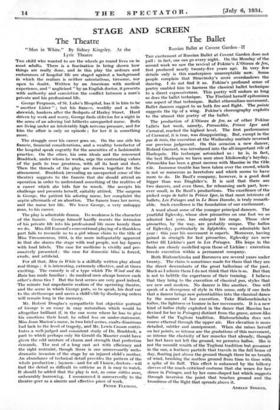The Ballet
Russian Ballet at Covent Garden—II THE excitement of Russian Ballet at Covent Garden does not pall : in fact, one can go every night. On the Monday of the second week we saw the revival of Fokine's L'Oiseau de feu, first produced nearly 'twenty-five years ago. In very few details only is this masterpiece unacceptable notv. Some people complain that Stravinsky's score overshadOws the dancing. I do not find it so. Fokine's profound sense of poetry enabled him to harness the classical ballet technique to a direct expressiveness. This poetry will endure as long as does the ballet technique. The Firebird herself epitomizes one aspect of that technique. Ballet etherealizes movement. Ballet dancers suggest to us both fire and flight. The pointe suggests the tip of a wing. Fokine's choreography exploits to the utmost this poetry of the ballet.
The production of L'Oiseau de feu, as of other Fokine ballets last week, namely, Petrouchka, Prince Igor and Carnacal, reached the highest level. The first performance of Carnacal, it is true, was disappointing. But, except in the pas de trais, the execution at the Wednesday matinee reversed our previous judgement. On this occasion a new dancer, Roland Guerard, was introduced into the all-important role of Harlequin. His technique' astonished us : he is, in fact, the best Harlequin we have seen since Idzikowsky's heyday. Petrouchka has been a great success with Massine in the title Wile. Immense trouble has been taken over the crowd, which is not so numerous as heretofore and which seems to have more to do. De Basil's company, however, is a good deal bigger than was Diaghilev's. It is said that there are two dancers, and even three,, for rehearsing each part, how- ever small, in De Basil's productions. The excellence of the picked corps de ballet in Prince Igor, in that most intricate of ballets, Les Presages and in Le Beau Danube, is truly remark- able. Such excellence is the foundation of our excitement.
A word about some of the younger principal dancers. The youthful Eglevsky, whose slow pirouettes on one foot we so admired last year, has enlarged his range. Those slow pirouettes, by the way, are probably unique. The ballon of Eglevsky, particularly in Sylphides, was admirable last year : this year his movement is superb. Moreover, having gained in strength for fast pirouettes, Eglevsky can now better fill Lichine's part in Les Presages. His leaps in the finale are closely modelled upon those of Lichine : execution breeds execution within a permanent company.
Both Riabouchinska and Baronova are several years under twenty. The claim is sometimes made for them that they are the direct descendants of the great ballerinas of the past. Much as I admire them I do not think that this is so. But that is not to belittle the expertness of their training. I believe that they bring to the execution of classical pas, styles that are new and modern. No dancer is like another. One will speak of a divergence of style in this sense, only if one feels
that a dancer brings new potentialities into the classical dance by the manner of her execution. Take Riabouchinska's
ballon, the lightness or bounee in her movements. It is a new kind of ballon (fully exploited in the dance that Massine has devised for her in Presages) distinct from the grave, arrow-like ballon of the Taglioni tradition. Riabouchinska does not course ethereal through the upper air. Her elevation is more detailed, subtler and omnipresent. When she raises herself
on her points, so intense are the gradations of this movement,
so intense the elasticity of her muscles that already, though her feet have not left the ground, we perceive ballon. She is
not the moonlit wraith of the Taglioni tradition but gossamer in the sun, a feathery particle that travels in the full beam of day, floating just above the ground though there be no breath of wind, brushing the restless ground from time to time with a spike of its fluff. This effect is enhanced by the billowy sleeves of the much criticized costume that she wears for her
dance in Presages, and by her cone-shaped hat which suggests through inversion the point that touches ground and the broadness of the flight that spreads' above it.
ADRIAN STOKES.










































 Previous page
Previous page